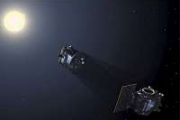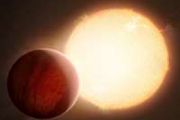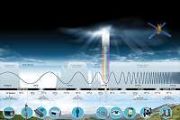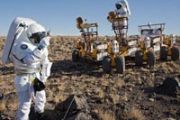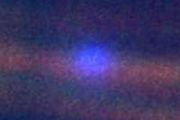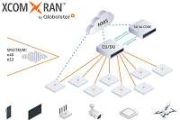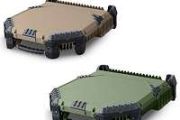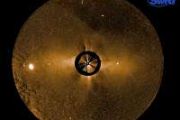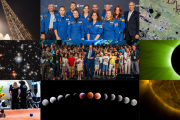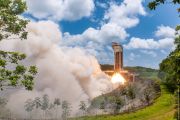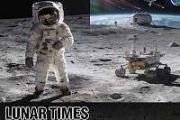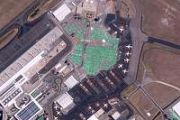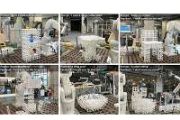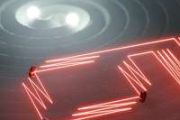
Copernical Team
Planet collaborates with ESA to advance Greek satellite services
 Planet Labs PBC (NYSE: PL), a key player in delivering daily Earth observation data, has entered a new agreement with the European Space Agency (ESA) to support Greece's National SmallSat Programme. This initiative, led by the Hellenic Ministry of Digital Governance and financed through the Recovery and Resilience Fund (RRF) Greece 2.0, will utilize Planet's commercial satellite data to bolster
Planet Labs PBC (NYSE: PL), a key player in delivering daily Earth observation data, has entered a new agreement with the European Space Agency (ESA) to support Greece's National SmallSat Programme. This initiative, led by the Hellenic Ministry of Digital Governance and financed through the Recovery and Resilience Fund (RRF) Greece 2.0, will utilize Planet's commercial satellite data to bolster Molecule's "fingerprint" may help explain formation of life on earth
 The chemical element sulphur is essential for all life forms and is a building block of proteins and amino acids. By studying sulphur-based molecules in space, scientists are working to understand the chemical processes that might have led to the formation of life on Earth.
German researchers from the Max Planck Institute for Extraterrestrial Physics recently discovered a special type of m
The chemical element sulphur is essential for all life forms and is a building block of proteins and amino acids. By studying sulphur-based molecules in space, scientists are working to understand the chemical processes that might have led to the formation of life on Earth.
German researchers from the Max Planck Institute for Extraterrestrial Physics recently discovered a special type of m Deep sea neutrino study places tighter constraints on quantum gravity
 Quantum gravity, the elusive framework that would merge general relativity with quantum mechanics, remains one of modern physics' greatest unsolved puzzles. One of the most promising candidates for shedding light on this conundrum is the neutrino-a ghost-like particle that carries no electric charge and almost never interacts with matter, passing through the Earth undisturbed.
Because of t
Quantum gravity, the elusive framework that would merge general relativity with quantum mechanics, remains one of modern physics' greatest unsolved puzzles. One of the most promising candidates for shedding light on this conundrum is the neutrino-a ghost-like particle that carries no electric charge and almost never interacts with matter, passing through the Earth undisturbed.
Because of t NASA Uses Advanced Radar to Track Groundwater in California
 Where California's towering Sierra Nevada surrender to the sprawling San Joaquin Valley, a high-stakes detective story is unfolding. The culprit isn't a person but a process: the mysterious journey of snowmelt as it travels underground to replenish depleted groundwater reserves.
The investigator is a NASA jet equipped with radar technology so sensitive it can detect ground movements thinne
Where California's towering Sierra Nevada surrender to the sprawling San Joaquin Valley, a high-stakes detective story is unfolding. The culprit isn't a person but a process: the mysterious journey of snowmelt as it travels underground to replenish depleted groundwater reserves.
The investigator is a NASA jet equipped with radar technology so sensitive it can detect ground movements thinne KONGSBERG enters satellite operations with inaugural launch
 Kongsberg Defence and Aerospace (KONGSBERG) has taken a major step into the space sector by launching and now operating its first microsatellite, marking the company's transition into satellite-based service provision.
The microsatellite, named ARVAKER 1 N3X, was deployed from Vandenberg Space Force Base in California aboard SpaceX's Transporter 13 mission. This launch not only signifies K
Kongsberg Defence and Aerospace (KONGSBERG) has taken a major step into the space sector by launching and now operating its first microsatellite, marking the company's transition into satellite-based service provision.
The microsatellite, named ARVAKER 1 N3X, was deployed from Vandenberg Space Force Base in California aboard SpaceX's Transporter 13 mission. This launch not only signifies K Exolaunch to Deploy Canadian CubeSats in Support of STEM Space Initiative
 Exolaunch has finalized a Launch Services Agreement (LSA) with the Canadian Space Agency (CSA) to facilitate the deployment of CubeSats under the CUBICS (CubeSats Initiative in Canada for STEM) program. This initiative seeks to enhance Canada's space technology capabilities while equipping the next generation of Canadian space professionals with hands-on experience.
The agreement covers th
Exolaunch has finalized a Launch Services Agreement (LSA) with the Canadian Space Agency (CSA) to facilitate the deployment of CubeSats under the CUBICS (CubeSats Initiative in Canada for STEM) program. This initiative seeks to enhance Canada's space technology capabilities while equipping the next generation of Canadian space professionals with hands-on experience.
The agreement covers th AI boosts accuracy in stellar classification efforts
 AI tools are revolutionizing the way astronomers study celestial bodies, offering new levels of precision and automation in classifying stars. A global research collaboration recently demonstrated how deep learning algorithms and large language models can efficiently and accurately categorize stars based on their light curves. The findings, published on February 26 in *Intelligent Computing*, ar
AI tools are revolutionizing the way astronomers study celestial bodies, offering new levels of precision and automation in classifying stars. A global research collaboration recently demonstrated how deep learning algorithms and large language models can efficiently and accurately categorize stars based on their light curves. The findings, published on February 26 in *Intelligent Computing*, ar South Pole Aitken Basin impact dated to early Moon history by Chang'e 6 samples
 Scientists have precisely determined the age of the Moon's largest and most ancient impact crater, the South Pole-Aitken (SPA) basin, using rock samples retrieved by China's Chang'e-6 lunar mission. A research team led by Prof. CHEN YI at the Institute of Geology and Geophysics of the Chinese Academy of Sciences analyzed the first samples ever collected from the SPA region and established that t
Scientists have precisely determined the age of the Moon's largest and most ancient impact crater, the South Pole-Aitken (SPA) basin, using rock samples retrieved by China's Chang'e-6 lunar mission. A research team led by Prof. CHEN YI at the Institute of Geology and Geophysics of the Chinese Academy of Sciences analyzed the first samples ever collected from the SPA region and established that t NASA's Curiosity Rover Detects Largest Organic Molecules Found on Mars
 Researchers analyzing pulverized rock onboard NASA's Curiosity rover have found the largest organic compounds on the Red Planet to date. The finding, published Monday in the Proceedings of the National Academy of Sciences, suggests prebiotic chemistry may have advanced further on Mars than previously observed.
Scientists probed an existing rock sample inside Curiosity's Sample Analysis at
Researchers analyzing pulverized rock onboard NASA's Curiosity rover have found the largest organic compounds on the Red Planet to date. The finding, published Monday in the Proceedings of the National Academy of Sciences, suggests prebiotic chemistry may have advanced further on Mars than previously observed.
Scientists probed an existing rock sample inside Curiosity's Sample Analysis at Mainland Europe's first orbital rocket launch postponed
 A German start-up on Monday postponed a test flight of its Spectrum rocket from Norway's Andoya Spaceport in the Arctic, seen as a key step in Europe's new space economy.
The Munich-based company Isar Aerospace said in a statement it had cancelled Monday's flight "due to unfavourable winds" and that it was working to find a new launch date.
A re-scheduled launch would be the first flight
A German start-up on Monday postponed a test flight of its Spectrum rocket from Norway's Andoya Spaceport in the Arctic, seen as a key step in Europe's new space economy.
The Munich-based company Isar Aerospace said in a statement it had cancelled Monday's flight "due to unfavourable winds" and that it was working to find a new launch date.
A re-scheduled launch would be the first flight 



